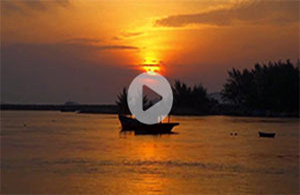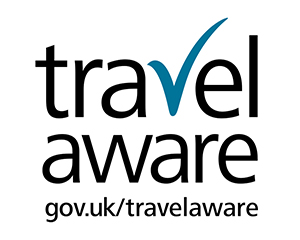.jpg)
Fact-finding tour to Vietnam
I recently travelled to Vietnam for a very brief fact-finding tour, gathering information to help our gap year students plan their travels in this wonderful country. I have previously visited Laos, Thailand and Myanmar (February this year), so I was really keen to see why Vietnam rated so highly. I travelled as a gap year student, staying in dormitories, hostels and getting about by both bus and train. Whilst in Saigon, I had a very useful meeting at the British High Commission.I say Saigon as I didn’t see a single bus or train timetable or a local person who referred to it as Ho Chi Minh.
Delightful people, best budget food and so much to see
It’s apparent that Vietnam is changing fast. Chinese investment is clearly visible especially in the coastal resorts and I do worry that many historic buildings and some stunning countryside will fall foul of the drive for commercial success. But on a positive note, the people are generally delightful, it's the best budget food I have ever experienced and there is so much to see. I didn’t have time to go to the Sapa region in the north west of the country or Halong Bay, but by all accounts the former is a must, the latter maybe is a little over visited but still spectacular. However, do check the weather; I knew it was at the end of the rainy season in South East Asia and boy did I see some rain! Weather-wise the best time to visit is mid November through to April or May.
I felt very safe in Vietnam and I was happy to walk out with a telephone in my pocket, which I simply would not do in most of the Latin American cities. Karen Gibbons from The British Consulate had some useful advice when I asked what were the main dangers that young travellers faced. Her reply; motorbike accidents and tainted drugs. On the latter, it’s not the threat of being arrested, it’s taking drugs with dangerous substances in them. A British traveller died in this manner last year.
Motorbikes in Vietnam
So onto motorbikes. I did the trip from Hue An to Hui via the Hai Van pass but on the back of an experienced rider’s bike. I used a company called Adventure Motorbikes who were excellent and we had my rucksack strapped to the back of the bike. Karen Gibbons explained the majority of accidents happen to inexperienced riders hiring their own motorbikes along with a ‘toy’ helmet. Whilst it’s not really being enforced, as of March this year, to drive a motorbike over 50cc you must have an international motorbike licence. One of the reasons I went on the back of someone else’s bike was that it was extremely wet and therefore the road would be and was very slippery. If do you plan to tour Vietnam on a motorbike, do ensure that you have done as a minimum a CBT Motorbike course in the UK, know how to ride a motorbike and bring your own helmet. Of note, the cost of my one-day tour from Hui An to Hue was $36. But let’s be clear, it's a very dangerous activity as the road is very busy with trucks, petrol tankers and lots of other motorbikes and cars.
Hostels, buses and crossing the road!
In Saigon, I stayed at the Prei Nokor Hostel. The hostel is situated at the back of a coffee shop and is opposite the Ben Thanh market. A number 152 bus from the airport drops you about 200 metres away for a princely fee of about $0.50. The hostel is small and well managed; its major drawback is a lack of a common seating area. A dormitory bed was around the $6 mark. They recommended an excellent local restaurant called Bep Me In, 136/9 Le Thanh Tom. Most of the bars and clubs are in Bui Vien street which is a 10-minute walk. There isn’t a huge amount to see in the city but it’s good for just wandering. The War Remnants museum is certainly well worth a visit but not a cheery experience as there are some vary graphic and gory photographs. It covers the period of the war against France in the late 1950s through to the end of the Vietnam War (known locally as the American War) in 1975. If this city is your first in Vietnam, you will quickly need to learn how to cross the road. If you plan to wait for the scores of motorbikes to stop, even at a pedestrian crossing, think again or you will die of old age on the side of the road. To cross, just walk slowly in a straight line and the traffic can judge your path and go around you.
My next stop was Da Lat known for its adventure sports. I took a night bus, FUTA Lines (orange buses) which was excellent. The night bus had beds each with a curtain, light and USB charging socket. The cost was about $12. Later in my trip, I took another night bus from Hue to Hanoi using a different company that was awful so do stick to FUTA Lines. Da Lat, whilst larger than I had imagined, has a hill station feel to it. You can go canyoning (safety massively improved since three deaths a few years ago), walking or mountain biking as I did. There are masses of hostels to stay in and adventure companies offering a range of activities. An Café is good for breakfast.
I was in a rush, so I bused onto Nha Trang which is a busy but a rather joyless beach resort. On the upside, it does have some good restaurants but it’s certainly not a backpacker’s destination. The prime reason for going there was to take the train to Da Nang which was a relaxed 8-hour experience. The trains are comfortable but not necessarily very good at time keeping and there are only two or three options per 24-hour period. The cost was approximately $12. There are also some good sleeper train options; Hue to Hanoi, Da Nang to Saigon. One advantage of the train is the stations are in the centre of towns/cities whereas, for example, the Hanoi main bus station is 9km outside the old city so another bus or taxi is needed to get into the city centre. Da Nang has good beaches (the US Marines came ashore here in March 1965 as the first combat troops) but has little else to offer and most people head onto Hui An, some 20km to the south.
Coastal Towns, Restaurants, Bars and Markets in Vietnam
The coastal towns of Hui An and Hue are well worth a visit, especially Hui An. It has a vibrant back-packer feel, is small and a good place for relaxing. It is littered with tailors if you want to get some clothes made, it has some interesting but not that old buildings to see and good shopping with a thriving market. I can thoroughly recommend Backhome Hostel, 39 - 41Ba Trieu, Phoung Cam Pho. It’s more like a hotel than a hostel with loads of rooms and dormitories, a large bar and a spacious common seating area. My 4-person dormitory cost $4. Hui An has a plethora of bars and a huge range of restaurants. It is busy, the Chinese and Japanese tour companies have certainly found it as a destination as it’s particularly spectacular at night where it lights up by lanterns.
Hue is certainly less of a happening town, but the old Imperial Palace is well worth a visit. It was nearly destroyed in the American War but is gradually being restored. It's a large site so plan a few hours to see it all. In Hanoi, the hostel Backpackers Central comes well recommended and is well positioned in the heart of the Old City.
Budgetting
How much to budget? I would say around $30 to $35 per day. So much depends on the amount of activities you are planning as these can be expensive with prices fueled by the arrival of mass tourism. A day trip canyoning, mountain biking or motor biking will probably cost between $30 to $50 but a museum or palace entry around $1 to $2. Dormitory beds in hostels are $5 and a meal maybe about the same. An overnight bus trip about $10 or $12. So working on the assumption that you might do a significant activity every 3rd or 4th day, I believe a budget of $30/$35 should be sufficient. However, if planning to have a relaxed day doing very little then one can get by on $10/15 for the day.
If travelling to South East Asia, I would plan for a minimum of two weeks in Vietnam. If you stay under 15 days as a UK citizen you don’t need a visa but you will need proof of departure. If you are staying between 15 and 30 days, you can get an e-visa and a full tourist visas is needed for more than 30 days.
Charlie McGrath
| Thu 18 Dec 25 | London | 3 | left |
| Tue 30 Dec 25 | Virtual | 5 | left |
| Thu 08 Jan 26 | London | 4 | left |
| Thu 15 Jan 26 | London | 0 | left |
| Wed 21 Jan 26 | Virtual | 7 | left |
| Wed 11 Feb 26 | London | 10 | left |
| Thu 26 Feb 26 | Virtual | 8 | left |
12 Dec, 2025
Thailand/Cambodia: Fighting restarts
Chile: Elections run on on 14 Dec
Indonesia: Over 900 dead from flooding in multiple areas
Sri Lanka: Flooding in Nov & Dec...
10 Dec, 2025
Do check with the Foreign and Commonwealth Development Office as the picture changes the whole time. Entry requirement...
05 Jan, 2025
Essential Tips for Gap Year Travel Safety Overseas
Here are just a few tips and tricks which can help gap year travellers when planning their travel overseas.
FCDO
Before ...

We use cookies to provide you with a better website experience. Close this popup to carry on browsing, or click here to find out more about cookies


